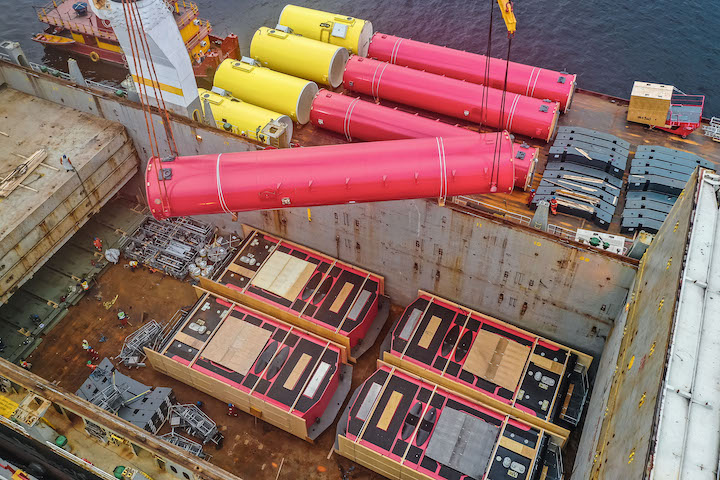• The barge-slewing cranes of type LBS 800 are the largest harbour cranes over floating pier, and the port is the first in the world to feature them in their operations
• A special boom length of 66 metres allows the cranes to reach large freighters with a width of up to 23 rows of containers, further supported by a 9.6-metre tower extension for better overview for the crane operators
• Performance is enhanced by the inclusion of electric drives for more reliable, high-speed turnover and fewer local emissions
The contract for the purchase of four cranes was signed during the Intermodal event in São Paulo in 2022. The cranes were delivered in September and are now part of a fleet of 16 barge-slewing cranes in operation at the port. Founded in 1987, Porto Chibatão plays a crucial role in the logistical operations and economic impact on the regional economy. It serves the Manaus industrial park, also known as the Manaus free trade zone, and is essential for processing increasing cargo volumes in the region.
Two pioneers for Brazil. Since 2007, Liebherr and Porto Chibatão have been building upon a successful and growing business partnership. It has been characterized by a growth strategy that included an early adoption of Liebherr FCC and LBS type cranes at the port, trendsetting in the world. Porto Chibatão today is the biggest private port and Liebherr port equipment customer in Latin America, featuring 42 different cranes, including gantry cranes, fixed cargo cranes, and barge-slewing cranes.
The port spans an impressive one million square metres. Its static load capacity stands at a staggering 40,000 TEUs, demonstrating its ability to handle substantial cargo volumes with ease. The four LBS 800 are equipped for container handling and have a turnover of up to 35 containers per hour and can lift up to 104 tonnes. To accommodate improved visibility during operations, the cranes were also built with a tower extension. Based on the latest Liebherr mobile harbour crane design, the cranes also feature an updated interior cabin and a more digital architecture overall that paves the way for partial automation and future assistance systems.

Supporting the local and global supply chains
Shipping and port logistics continue to play a key role in the global supply chain. Porto Chibatão’s berthing facility consists of 1,026-metres-long floating pier or quay for embarking and disembarking ships coming from long-haul navigation and cabotage. It has the capacity to simultaneously operate eight vessels with drafts of up to 20 metres. Among the important shipping companies that use the harbour are Hamburg Süd, Maersk Mercosul Line, Log-In, CMA-CGM, MSC, and general cargo ships and steel products destined for the Manaus Industrial Pole. Products include materials from the textile industry, electronics, and two-wheelers, among many other goods.
“As a leading port operator in Brazil, we are always looking for innovative solutions to improve our performance and sustainability,” notes Jhony Fidelis, General Executive Director of Grupo Chibatão. “These particular LBS 800 cranes from Liebherr are a perfect fit for our vision, as they offer high productivity and low emissions. We are proud to work with Liebherr, a company that shares our commitment to excellence and fostering environmental responsibility.”
Larger cranes for rising demands
In recent years, Porto Chibatão received the go-ahead from Antaq, Brazil’s ports and waterways regulatory agency, to move forward with its 98 million reais – about €18.3 million – expansion plan to lengthen the floating pier from 710 metres to 1,026 metres. The expansion is needed to process increasing cargo volumes in the Manaus industrial park.
The trend for transporting commodities is ultimately towards larger and more goods, overall. Successful ports orient themselves around an effective growth strategy. It’s been almost ten years since the first LBS 600 was delivered to Porto Chibatão. With the LBS 800, a new marker has been set. And the needs of the future can be effectively met, today.

Follow us on social media: